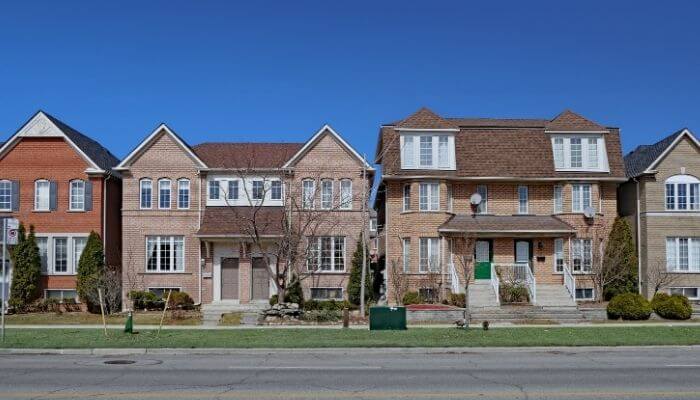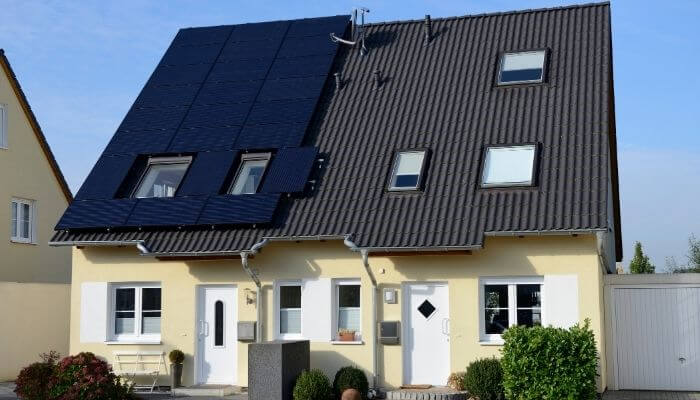Soundproofing a semi-detached home is rarely as simple as just soundproofing your party walls.
Semi-detached homes can share ceiling joists which sound can travel through, there may also be holes in the walls where the joists run which allows sound in.
To properly soundproof between semi-detached homes a thorough and complete approach to soundproofing is required.
Before you dive headfirst into soundproofing a party wall work out exactly where the noise is coming getting in. It may be that the bulk of the noise is actually traveling through shared joists.
The key things you need to consider are:
- Floors
- Party Walls
- Window Walls
- Ceilings
1. Floors
It is not uncommon for semi-detached properties to share floor joists. If this is the case in your property then this is likely to be one of, if not the main, causes of your noise problems.
Shared floor joists allow sound vibrations to travel across the joist and through the wall before resonating through your floor.
This means that you are likely to hear impact sounds (sounds which travel via vibrations) such as footfall and plug sockets being used.
The most effective way of fixing this issue is to soundproof the joists by decoupling them.
This involves cutting the joist so that they are no longer connected and are secured independently, it is also a good idea to fill the joist holes in the wall to prevent any airborne sound from traveling through.
Often doing this can completely resolve all noise problems.
2. Party Walls
Party walls account for the largest surface area that you share with your neighbor.
If you have a poorly soundproofed party wall you will know about it!

Most party walls are usually built from brick with a cavity in the middle which does a good job of minimizing sound transfer, some cavity walls may still need soundproofing.
If your property was built before 1920 then there is a strong chance that any external and party walls will no contain a cavity but instead just has solid walls.
This means that if your neighbor was to hit the wall the vibrations would travel directly through into your home with no cavity to block the path of the vibrations. The result of this type of construction is that all impact noise is easily audible through the wall.
Thankfully there are a lot of things you can do to soundproof a wall, even if it has no cavity!
If you do have a cavity in your wall try filling it with insulation foam. This serves two purposes:
- It helps insulate your home.
- It helps deaden sound as the sound energy bounces off the insulation foam wasting energy before it gets through the cavity.
If you don’t have a wall cavity or you want to further soundproof your cavity wall then installing soundproof panels is a great option.
These work by reducing vibrations through your wall, they usually measure between 25mm to 40mm thick and they comprise of a dense rubber laminate board or mass loaded vinyl sandwiched between a layer on either side of the acoustic plasterboard.
The rubber core does a great job of deadening impact vibrations.
Typically the panels measure around 1m x 1m. Simply buy enough to cover the wall.
Cut them to size, screw them into the wall (this will require a drill and some wall plugs), decorate and you’re good to go!
The most effective method of soundproofing any wall is to use the room within a room method.
This involves building a second ‘false wall’ in front of your party wall. This creates a false cavity in your room which effectively decouples your wall meaning that vibration can’t travel from the brick wall into your false wall.
This is an extremely effective soundproofing method and one which we strongly recommend implementing in semi-detached properties with serious noise problems.
Soundproofing Your Chimney stacks
If you share a chimney stack with your neighbor it is common to not bother soundproofing it.
Yet you should.
Chimneys in party walls (particularly in old homes) can share structural elements which mean vibrations will pass easily through the chimney walls.
Some chimneys (again typically in old homes) may have a connected chimney flue which can allow air-borne sound to pass through them.
Addressing your chimney stack is important in soundproofing between semi-detached homes.
Many modern homes do not use their chimney at all with central heating systems being efficient and easy to use. If that is the case for you then it is a good idea from a soundproofing perspective to completely get rid of your chimney stack.
This will allow for the party wall to be properly soundproofed without having to go around your chimney thereby compromising the noise resistance efficiency.
Granted getting your chimney stack removed will be expensive and messy so we understand if you don’t fancy, instead just make sure that you soundproof around the chimney stack.
3. Window Walls
Window walls do not stand between you and your neighbor so it is common for these to not be considered in a semi-detached soundproofing project.
This is a mistake.
Your window walls are coupled (securely connected) to your party wall. So vibrations will travel through into your window wall.
Failing to treat your window wall may leave you still hearing the noise even if you deal with the party wall and flooring.
There are a couple of strategies that can be employed to soundproof a window wall effectively:
- Cover the wall with a soundproof board. This will deaden vibrations that travel into the wall and prevent noise from reaching your ears.
- Decouple your wall from the party wall. This is only possible if you create a room within a room, you can then use resilient channels and green glue to prevent the wall structures from touching.
4. Ceilings

Soundproofing your ceiling isn’t necessary but it is a valuable thing to consider doing to finish off a semi-detached soundproofing project.
It will help isolate your room and prevent noise from upstairs leaking in (which is particularly important if you live in a flat).
To soundproof your ceiling you will need to:
- Insulate The Ceiling Cavity – to do this you will need to remove the plasterboard and fill the cavity with a flame retardant insulation such as RockWool (which has a melting point of over 1100°C ). Cut the insulation so that it fits into the gaps between your ceiling joists with about 10cm extra insulation. This can then be compressed into place and it should stay there without any fixation required. Add at least a couple of layers of insulation throughout the entire ceiling cavity. Then simply put your ceiling panels back.
- Add Resilient Channels – Resilient channels are purpose made metal strips are designed to decouple plasterboard or ceiling panels from the ceiling structure, they can also be used on walls.They work by having minimal contact with the ceiling joists and by being padded with rubber so that vibration transfer is minimal. They get their name from the small channels in them which use up the sound energy as it travels through the metal. Screw the channels across your ceiling joists every couple of feet and then attach your ceiling panels to them making sure that the screws only screw into the resilient channel, not the joists.
- Replace Your Plasterboard With Soundproof Ceiling Panels – Soundproof ceiling panels are just like normal ceiling panels except they contain a rubber layer in the middle to deadening vibrations. If you are using resilient channels then screw the panels into the channels, if you’re not using channels screw the panels into your ceiling joists.
A lot of this work can be difficult if you’re not much of a D.I.Y enthusiast so don’t be afraid to consult a specialist soundproofing company.
Soundproofing a party wall in a semi-detached home can transform your home life from a living nightmare into blissful peace. We hope this article has proved useful in helping you with your noise problem.
As an Amazon Associate I may earn a small fee from qualifying purchases at no extra cost to you. This helps us run the site, so thanks for your support!